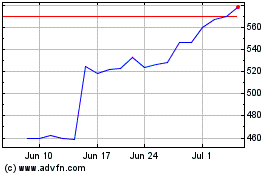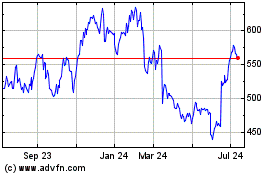Creativity Pays: Global Survey From Adobe Links Being Creative to Stronger Personal and Professional Success
November 01 2016 - 9:00AM
Business Wire
Eighty-five percent of U.S. respondents say creativity makes
them better leaders, parents and students
On the eve of Adobe MAX 2016, the world’s premier creativity
conference, Adobe (Nasdaq:ADBE) today released global survey
findings that show investing in creativity pays off with tangible
benefits – from higher income to greater national competitiveness
and productivity. The report, “State of Create: 2016,” which
surveyed more than 5,000 adults across five countries, reveals
people who identify as creators globally report household income
that is 13 percent higher than non-creators. Globally, more than
two-thirds believe that being creative helps make people better
workers, leaders, parents and students.
This Smart News Release features multimedia.
View the full release here:
http://www.businesswire.com/news/home/20161101005672/en/
(Graphic: Business Wire)
“An investment in creativity and design is simply good
business,” said Mala Sharma, vice president and general manager of
Creative Cloud at Adobe. “Creativity and productivity go hand in
hand, but investing in creativity isn’t on the agenda for enough of
today’s leaders. This survey provides a big wake-up call to
businesses that they need to think differently and give employees
the tools and freedom to be creative.”
U.S. respondents rated the importance of creativity higher than
the global average across many dimensions shown below. Key findings
from U.S. respondents include:
Creativity delivers benefits for creators, economy and
society
Creativity has permeated every aspect of society and has become
vital to financial and economic success.
- A large majority of U.S. respondents
agrees that being creative is valuable to the economy (77 percent)
and society (82 percent).
- Being creative drives self-worth.
Creators are more likely than non-creators to identify themselves
as innovative (+27 percentage points), confident (+21 percentage
points), problem solvers (+11 percentage points) and happy (+15
percentage points).
- Being creative pays: Based on their
reported household income, U.S. creators earn 17 percent more than
non-creators.
- Yet only five in 10 respondents (55
percent) describe themselves as creative and 44 percent say they
are living up to their creative potential.
Creativity and design make for good business
Creativity’s benefits are not just for individuals – businesses
benefit from prioritizing creativity and good design.
- Most U.S. respondents believe
businesses that invest in creativity are more likely to foster
innovation (88 percent), be competitive (88 percent), provide
better customer experience (88 percent), have satisfied customers
(89 percent) and be financially successful (85 percent).
- Respondents also say such businesses
are more likely to have happier employees (88 percent) and
increased employee productivity (88 percent).
- Eighty-three percent agree there is
increasing pressure to be productive rather than creative at work.
However, six in 10 (62 percent) say people are increasingly
expected to think creatively at work.
- Eighty-three percent of respondents
also agree that it is important for businesses to focus on good
design. More than half (57 percent) say that in the past year
alone, they have paid more for a product or service that had good
design.
Governments and schools have a creativity imperative
Governments that invest in creativity are viewed more positively
by U.S. respondents, but there is a clear disconnect between the
high value society places on creativity and the lack of investment
in creative education.
- U.S. respondents overwhelmingly
perceive that a government that invests in creativity is more
likely to increase productivity (89 percent), foster innovation (87
percent), have happier citizens (86 percent) and be competitive (85
percent).
- Eighty-three percent of respondents
believe that unlocking creative potential is key to economic
growth. Yet 79 percent feel the U.S. is not living up to its
creative potential.
- Seventy-one percent of respondents
believe that creativity is being stifled by the educational system,
and only 41 percent feel that the government encourages schools to
teach students to be creative.
- A large majority wants schools to do
more to foster creativity – by prioritizing “learning by doing”
over direct instruction (85 percent), developing a wide variety of
student skills over specialized skills (79 percent) and teaching
creativity over memorization (78 percent).1
Japan seen as the most creative country
In addition to their views on creativity, respondents were asked
for their opinions on the most creative country and city in the
five countries surveyed. Globally, Japan is regarded as the most
creative country (34 percent) and Tokyo the most creative city (26
percent), followed by the U.S. (28 percent) and New York (23
percent), respectively.
About the Adobe “State of Create: 2016” Study
The “State of Create: 2016” study findings came from an online
survey of 5,026 adults (18+ years of age) in the U.S., U.K.,
France, Germany and Japan. Research was conducted from Sept. 19,
2016 to Oct. 3, 2016. The report was commissioned by Adobe and
produced by the research firm Edelman Intelligence. The margin of
error for the U.S. sample is +/- 3.1 percentage points and for the
global sample is +/-1.4 percentage points. This study builds on
research conducted among comparable audiences in March – April of
2012.
For more information about the Adobe State of Create Study,
please visit http://www.adobe.com/go/stateofcreate2016
Learn more about Adobe MAX 2016 announcements at
http://news.adobe.com/press-release/creative-cloud/worlds-top-creators-headline-adobe-max
About Adobe
Adobe is changing the world through digital experiences. For
more information, visit www.adobe.com.
1 A recent Adobe study of U.S. Gen Z students (ages 11-17) and
their educators supports these findings.
© 2016 Adobe Systems Incorporated. All rights reserved. Adobe
and the Adobe logo are either registered trademarks or trademarks
of Adobe Systems Incorporated in the United States and/or other
countries. All other trademarks are the property of their
respective owners.
View source
version on businesswire.com: http://www.businesswire.com/news/home/20161101005672/en/
AdobeRoman Skuratovskiy, 415-504-2855skuratov@adobe.com
Adobe (NASDAQ:ADBE)
Historical Stock Chart
From Mar 2024 to Apr 2024

Adobe (NASDAQ:ADBE)
Historical Stock Chart
From Apr 2023 to Apr 2024
